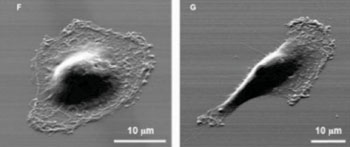Sorting and Selecting Cancer Cells by Their Motility Will Advance Understanding of Metastatic Processes
By LabMedica International staff writers
Posted on 04 Jun 2015
In order to develop a better understanding of the mechanisms that cause some cancer cells to break away from the primary tumor and migrate to other parts of the body, a team of cancer researchers has created an instrument for sorting and selecting cancer cells based on their motility.Posted on 04 Jun 2015
Tumor cell migration toward and into capillaries is an early and key event in cancer metastasis, yet not all cancer cells are imbued with the same capability to do so. This heterogeneity within a tumor is a fundamental property of cancer.

Image: Micrograph of individual cancer cells that were isolated according to their motility. The cell on the left is less likely to metastasize (Photo courtesy of University of Michigan).
Conventional in vitro migration platforms have so far related to cell populations as an aggregate, which has led to a masking of intrinsic differences among cells. While some migration assays have reported the ability to resolve single cells, these platforms did not provide for selective retrieval of the distinct migrating and non-migrating cell populations for further analysis.
Therefore, to study the intrinsic differences in cells responsible for chemotactic heterogeneity, investigators at the University of Michigan (Ann Arbor, USA) developed a single-cell migration platform so that individual cells’ migration behavior could be studied and the heterogeneous population sorted based upon chemotactic phenotype. Furthermore, after migration, highly chemotactic and non-chemotactic cells were retrieved and proved viable for later molecular analysis of their differences.
In addition, as described in a paper published in the May 18, 2015, online edition of the journal Scientific Reports, the investigators modified the migration channel to resemble lymphatic capillaries to better understand how certain cancer cells are able to move through geometrically confining spaces.
"This work demonstrates an elegant approach to the study of cancer cell metastasis by combining expertise in engineering and biology," said senior author Dr. Euisik Yoon, professor of electrical engineering, computer science, and biomedical engineering at the University of Michigan. "In past decades, engineers have developed biological tools with better resolution, higher sensitivity, selectivity, and higher throughput. However, without compelling applications, these engineering tools have little practical relevance. The goal of our lab is to develop tools that can be widely disseminated to the biology community to eventually impact clinical care for patients."
Related Links:
University of Michigan













